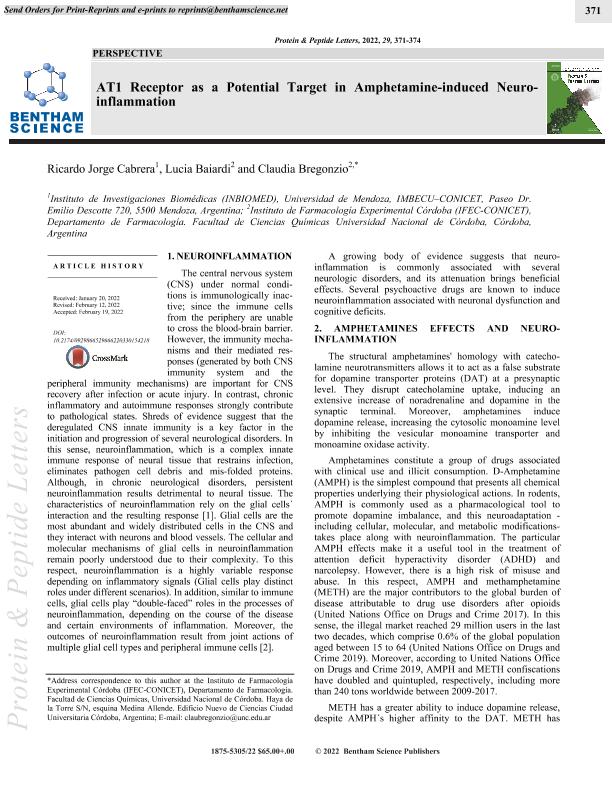Mostrar el registro sencillo del ítem
dc.contributor.author
Cabrera Kreiker, Ricardo Jorge

dc.contributor.author
Baiardi, Lucia
dc.contributor.author
Bregonzio Diaz, Claudia

dc.date.available
2023-07-20T11:43:25Z
dc.date.issued
2022-05
dc.identifier.citation
Cabrera Kreiker, Ricardo Jorge; Baiardi, Lucia; Bregonzio Diaz, Claudia; AT1 Receptor as a Potential Target in Amphetamine-induced Neuro-inflammation; Bentham Science Publishers; Protein and Peptide Letters; 29; 5; 5-2022; 371-374
dc.identifier.issn
0929-8665
dc.identifier.uri
http://hdl.handle.net/11336/204544
dc.description.abstract
Background: Amphetamines constitute a group of drugs associated with clinical use and illicit consumption. They induce dopamine neurotransmission and promote astrocyte reactivity and microglial activation events associated with their neurotoxic actions. The neuroinflammatory response induced by amphetamines occurs as a consequence of mechanisms that involve oxidative stress, glial reactivity and apoptosis. Brain angiotensin II, through its AT1 receptor (AT1-R), modulates dopaminergic, glutamatergic and GABAergic neurotransmission, which are involve in cognition, emotions and stress responses. AT1-R is present in neurons, astrocytes, microglia and endothelial cells having a key role in the development of an oxidative/inflammatory microenvironment. AT1-R promotes the initiation and progression of local brain inflammatory and oxidative responses under dopamine imbalance conditions. The available evidences support the protective effects of AT1-R blockade for the deleterious effects induced by amphetamine.Conclusion: The available evidences, together with the results obtained by our group, open the possibility to postulate AT1-R as a possible therapeutic target for neuroinflammatory responses associated with dopamine imbalanced related disorders.
dc.format
application/pdf
dc.language.iso
eng
dc.publisher
Bentham Science Publishers

dc.rights
info:eu-repo/semantics/openAccess
dc.rights.uri
https://creativecommons.org/licenses/by-nc-sa/2.5/ar/
dc.subject
ANGIOTENSIN
dc.subject
ATTENTION DEFICIT
dc.subject
PSYCHOSTIMULANTS
dc.subject
NEUROINFLAMMATION
dc.subject.classification
Neurociencias

dc.subject.classification
Medicina Básica

dc.subject.classification
CIENCIAS MÉDICAS Y DE LA SALUD

dc.title
AT1 Receptor as a Potential Target in Amphetamine-induced Neuro-inflammation
dc.type
info:eu-repo/semantics/article
dc.type
info:ar-repo/semantics/artículo
dc.type
info:eu-repo/semantics/publishedVersion
dc.date.updated
2023-07-07T18:44:18Z
dc.journal.volume
29
dc.journal.number
5
dc.journal.pagination
371-374
dc.journal.pais
Estados Unidos

dc.journal.ciudad
Oak Park
dc.description.fil
Fil: Cabrera Kreiker, Ricardo Jorge. Consejo Nacional de Investigaciones Científicas y Técnicas. Centro Científico Tecnológico Conicet - Mendoza. Instituto de Medicina y Biología Experimental de Cuyo; Argentina
dc.description.fil
Fil: Baiardi, Lucia. Consejo Nacional de Investigaciones Científicas y Técnicas. Centro Científico Tecnológico Conicet - Córdoba. Instituto de Farmacología Experimental de Córdoba. Universidad Nacional de Córdoba. Facultad de Ciencias Químicas. Instituto de Farmacología Experimental de Córdoba; Argentina
dc.description.fil
Fil: Bregonzio Diaz, Claudia. Consejo Nacional de Investigaciones Científicas y Técnicas. Centro Científico Tecnológico Conicet - Córdoba. Instituto de Farmacología Experimental de Córdoba. Universidad Nacional de Córdoba. Facultad de Ciencias Químicas. Instituto de Farmacología Experimental de Córdoba; Argentina
dc.journal.title
Protein and Peptide Letters

dc.relation.alternativeid
info:eu-repo/semantics/altIdentifier/doi/http://dx.doi.org/10.2174/0929866529666220330154218
dc.relation.alternativeid
info:eu-repo/semantics/altIdentifier/url/https://www.eurekaselect.com/article/122067
Archivos asociados
